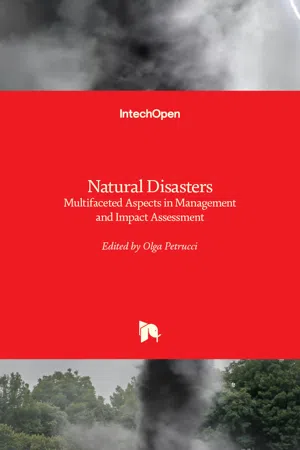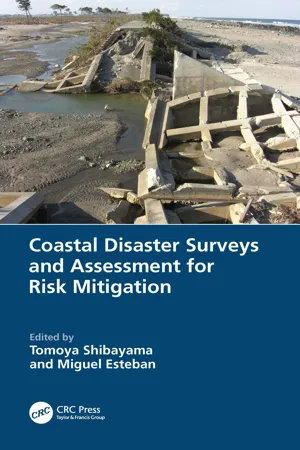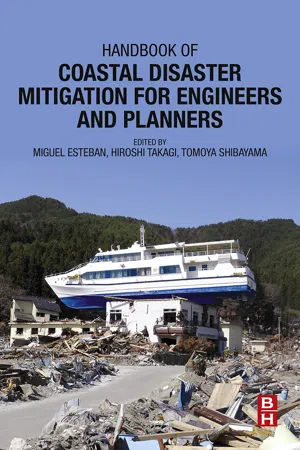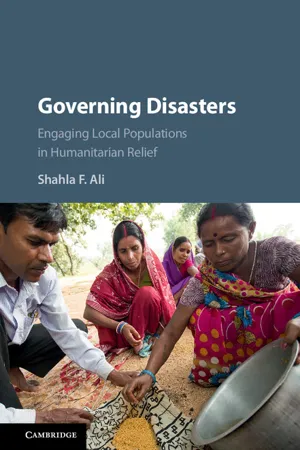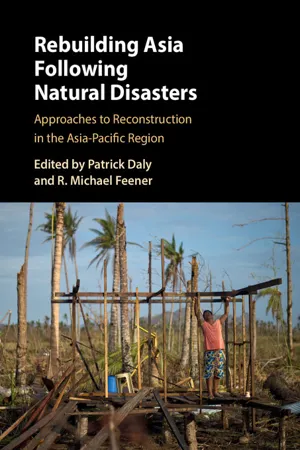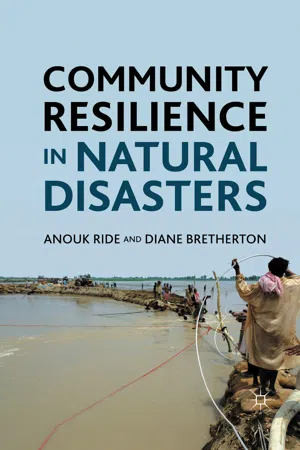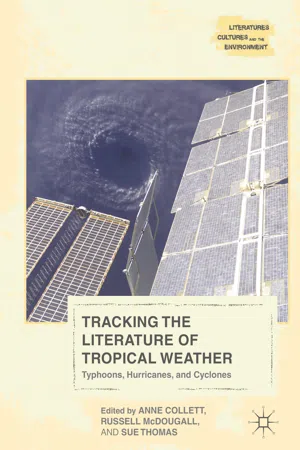Geography
Cyclone Nargis
Cyclone Nargis was a devastating tropical cyclone that hit Myanmar in May 2008. It was one of the deadliest cyclones in recorded history, with over 138,000 people reported dead or missing. The cyclone caused widespread damage to infrastructure and agriculture, and led to a humanitarian crisis in the affected areas.
Written by Perlego with AI-assistance
10 Key excerpts on "Cyclone Nargis"
- Carolina G. Hernandez, Eun Mee Kim, Yoichi Mine, Ren Xiao, Carolina G. Hernandez, Eun Mee Kim, Yoichi Mine, Ren Xiao(Authors)
- 2018(Publication Date)
- Palgrave Macmillan(Publisher)
© The Author(s) 2019Begin AbstractHuman Security and Cross-Border Cooperation in East Asia Security, Development and Human Rights in East Asia https://doi.org/10.1007/978-3-319-95240-6_6Carolina G. Hernandez ,Eun Mee Kim ,Yoichi Mine andRen Xiao (eds.)6. Cyclone Nargis in Myanmar: The Perfect Storm?
End AbstractBrendan Howe1(1) Graduate School of International Studies, Ewha Womans University, Seoul, Republic of KoreaIntroduction
Myanmar (also known as Burma) is a resource-rich emerging economy in Southeast Asia but remains one of the poorest countries in the region. Since independence from Britain in 1948, Myanmar has experienced a complex set of conflicts between successive governments and the people. The military seized power in a coup in 1962, and a series of military-dominated governments held sway until 2011. The country stands out as ‘a pre-eminent example of a post-colonial state subsumed in what development analysis describes as a conflict trap ’ (Smith 2007 , 3). Myanmar is also vulnerable to natural disasters , including cyclones , floods, storms, landslides, earthquakes, tsunamis , droughts and fires. Cyclone Nargis hit Myanmar on May 2, 2008. It was the deadliest natural disaster ever faced by the country and one of the most devastating storms recorded anywhere in the world.Nargis officially killed more than 140,000 people (UNEP 2009 , 3), although some put the toll at over 300,000 (Opposition #2 2016 ; Government #1 2016 ). The cyclone destroyed 707,500 tons of stored paddy and milled rice, 85% of all seed stocks were lost, 3,000 power tillers were lost, 37% of all orchard crops and 70% of backyard gardening were destroyed, and 28% of pigs, 52% of ducks, 30% of goats and 45% of chickens (UNFAO 2009 , 3–4). In the 11 most affected townships alone, 227,420 draught animals (50% of the buffalo and 25% of the cattle) were lost (UNFAO 2009 , 3–4). Nargis created further long-term humanitarian challenges. It had a devastating impact on the environment of the Irrawaddy and Yangon Divisions, where local livelihoods are heavily reliant on the natural resource base; 38,000 hectares of natural and replanted mangroves were destroyed, over 63% of the paddy fields were submerged, and 43% of all freshwater ponds were damaged (UNEP 2009 , 3). The cyclone caused widespread damage to agricultural infrastructure and buildings, and destroyed approximately 1,550 marine fishing vessels, up to 100,000 small inland fishing boats (50% of the fleet) and 70% of all fishing gear (UNFAO 2009 , 4). Approximately 800,000 people were displaced, of whom 260,000 sought shelter in camps and settlements throughout the delta (UNFAO 2009- eBook - PDF
Natural Disasters
Multifaceted Aspects in Management and Impact Assessment
- Olga Petrucci(Author)
- 2013(Publication Date)
- IntechOpen(Publisher)
1.2. Case study of Cyclone Nargis One of the least analyzed natural disasters of the past 20 years is the cyclone -- decep‐ tively named daffodil (Nargis) – that assailed the Subjective Well-Being (SWB) of small © 2013 Calkins and Win; licensee InTech. This is an open access article distributed under the terms of the Creative Commons Attribution License (http://creativecommons.org/licenses/by/3.0), which permits unrestricted use, distribution, and reproduction in any medium, provided the original work is properly cited. © 2013 The Author(s). Licensee InTech. This chapter is distributed under the terms of the Creative Commons Attribution License http://creativecommons.org/licenses/by/3.0), which permits unrestricted use, distribution, and reproduction in any medium, provided the original work is properly cited. scale farm families in the Irrawaddy Delta, Myanmar. On May 2, 2008, this cyclone rip‐ ped away the ability of those farmers to feed even themselves, much less others. They lost their families, means of livelihood, and property. Flooding, rains and storms surges washed out almost everything and left behind only barren land. The government stop‐ ped reporting the official death toll when it reached 138,000 people, but this is surely an underestimate; especially since the figure did not include the 55,000 people still missing at that time. Thus, Nargis victims in Myanmar easily surpassed the entire human loss (170,000 fatalities) suffered from the much better-known nine-country (Indonesia, Sri Lan‐ ka, India, Thailand, the Maldives, Somalia, Myanmar, Malaysia, Seychelles) tsunami of 2004 [2]. A significant portion of the Nargis deaths could probably have been avoided. No system or programs of disaster relief or prevention were in place in Myanmar at the time of the disas‐ ter. - Tomoya Shibayama, Miguel Esteban, Tomoya Shibayama, Miguel Esteban(Authors)
- 2022(Publication Date)
- CRC Press(Publisher)
Section 9.2 ). In contrast, the high death toll from Cyclone Nargis clearly highlights the danger that a severe tropical cyclone poses when it hits an area where people are less aware of the danger these weather systems represent (due to their relative smaller frequency). In addition, many residents did not evacuate during Nargis due to the misperception associated with past flooding experiences (as the areas are typically flooded several times a year due to heavy precipitation). Therefore, in addition to the rarity of the cyclone path and intensity, the lack of awareness and experience with such events likely contributed to the increase in human suffering due to this event.3.3.5 Conclusions
Cyclone Nargis in 2008 killed nearly 140,000 people, though given restrictions by the military regime in Myanmar at the time the true scale of the disaster was not well understood by the foreign community. In this chapter, an attempt was made to describe, albeit in a limited way, the storm surge generated by Cyclone Nargis, with reference to the results of some field surveys by international researchers. Storm surges of up to 5 m or more were observed over a wide area of the Irrawaddy Delta. Yangon, the capital of the country at the time, was also affected by the storm surge propagating through the Yangon River. Compared to its neighbour Bangladesh, Myanmar has historically been hit less frequently by cyclones, which may have contributed to a lack of awareness about such hazards. The case of Cyclone Nargis demonstrates that although the probability of a cyclone event taking place is low, when it does occur the consequences can be significant.3.4 Hurricane Sandy in 2012
Miguel Esteban Waseda University, Tokyo, Japan Takahito Mikami Tokyo City University, Tokyo, Japan Tomoya Shibayama Waseda University, Tokyo, Japan3.4.1 Introduction
On October 29, 2012, Hurricane Sandy made landfall along the eastern shorelines of the USA. The day before the storm arrived a mandatory evacuation order to the residents in Zone A (the area which was believed to be most likely to be flooded, including 375,000 residents), and a suspension of the rapid transit system (encompassing busses, subways, and trains) were carried out. The mayor and transportation authority repeatedly asked residents to recall the experience of Hurricane Irene in 2011 (New York City Government, 2014 ; MTA, 2014 ), as the same measures implemented during Sandy (a mandatory evacuation order and a suspension of the rapid transit system) were carried out during the passage of Irene (Mikami et al., 2015- eBook - PDF
- Bruce Anderson, Alan H. Strahler(Authors)
- 2012(Publication Date)
- Wiley(Publisher)
A s farmers were hurrying to finish harvesting rice across southeast Asia, the 2008 North Indian cyclone season—which runs from about May through November—was about to start with one of the deadliest storms on record. In the Bay of Ben- gal, east of India, on April 27, 2008, a low pressure system was intensifying. As the winds circling the central low pressure rose above 39 km/hr (63 mph), the storm was officially named Tropical Storm Nar- gis. One day later, the winds pushed past 119 km/hr (74 mph), and the storm was upgraded to cyclone (or hurricane) status. Initially it tracked northwest- ward towards India and Bangladesh, where a year earlier, Cyclone Sidr had made landfall, killing over 10,000 people. However, history would not repeat itself. On April 29, Cyclone Nargis shifted course, moved northeast, and then almost directly east- ward. It continued to intensify, with winds eventu- ally reaching 215 km/hr (135 mph). Following its eastward track, the hurricane made landfall on May 2 and moved parallel to the low-lying coast of Mayanmar, wreaking havoc as it went. As Nargis slowly made its way along the coast, the on-shore winds—which were still in excess of 130 km/hr (80 mph)—pushed a surge of water 6 m (20 ft) high far inland, flooding an area the size of Connecticut. Heavy rain poured down. Entire villages were sub- merged or torn asunder. In all, it is estimated that over 80,000 people died and over 50,000 went missing. Even these numbers may be low—in one township alone 80,000 people may have perished. In recent years, we have seen the extreme dev- astation wrought by tropical cyclones such as Cy- clone Nargis in Mayanmar and Hurricane Katrina in the United States. Such events remind us that we are still very much at the mercy of the weather. Tropical Weather Systems 244 9 CHAPTER OUTLINE ■ Tropical Cyclone Structure p. 246 ■ Development and Movement of Tropical Cyclones p. - Miguel Esteban, Hiroshi Takagi, Tomoya Shibayama(Authors)
- 2015(Publication Date)
- Butterworth-Heinemann(Publisher)
In comparison to neighboring countries like Bangladesh and India, cyclone induced damage had been comparatively lower in Myanmar before Nargis struck (Fritz et al., 2010). During the passage of Nargis most people in the Ayeyarwady Delta underestimated the damage that could result from storm surges and did not evacuate in time. Moreover, most people did not have any idea on how to prepare and where and when to evacuate due to a lack of any previous training on cyclone preparedness (PNPR I-IV (2008-2010)). By the time the affected communities realized the danger of the approaching cyclone it was too late. Another major cause for the heavy damage was the multitude of logistic problems which hampered relief supplies. Main roads and rivers were full of debris and therefore the delivery of relief materials was considerably delayed, which caused the death of many people in remote villages. Therefore, one of the main lessons learned from Cyclone Nargis was the need for better awareness on Disaster Risk Reduction (DRR) at the community level in Myanmar (Shikada et al., 2012) (Figure 20). Figure 20 Aerial photograph of the villages and newly constructed houses in the Ayeyarwady Delta, one year after Cyclone Nargis hit Myanmar. (Photo Credit: Ryo Matsumaru) After Nargis, different organizations took part in disaster management activities and noticeable progress was made on the relief to recovery process (Shikada et al., 2012) (Figure 21). The houses designed for those affected by the cyclone were upgraded in terms of the materials used in construction. In order to mitigate the risk from storm surge and other natural disasters, nine man-made hillocks were constructed in villages in the area. Mangrove plantation is being undertaken and wind breaking plantations are also being placed around some of the villages. The Swiss Development Cooperation-Humanitarian Aid (SDC-HA) constructed 42 schools that also act as cyclone shelters in rural areas of the Ayeyarwady Delta- eBook - PDF
Governing Disasters
Engaging Local Populations in Humanitarian Relief
- Shahla F. Ali(Author)
- 2016(Publication Date)
- Cambridge University Press(Publisher)
PART IV Examining Public–Private Partnerships 215 10 Myanmar’s Cyclone Nargis of 2008 Introduction This section will examine how public–private partnerships alongside state and national responses helped address the after effects of Cyclone Nargis in some villages in Myanmar. While the Cyclone Nargis disaster of 2008 can be characterized in some respects as an interventionist response that conflicted directly in some cases with domestic preferences, selected regions and territories within Myanmar provide innovative case studies of public–private partnerships. On May 2 and 3, 2008, Cyclone Nargis, a category 3 cyclone, struck the coast of Myanmar, making landfall in the Ayeyarwady Division, approxi- mately 250 km southwest of Yangon. The cyclone affected more than fifty townships, mainly in Yangon and Ayeyarwady Divisions. The damage was most severe in the Irrawaddy Delta region, where the effects of the extreme winds were compounded by a twelve-foot (3.6-meter) storm surge. 1 The disaster was the worst natural disaster in Myanmar as of that time, killing at least 140,000 people and leaving 3 million in urgent need of assistance. 2 The cyclone caused widespread destruction to homes and infrastruc- ture such as roads, jetties, water and sanitation systems, fuel supplies and power stations. A large number of water supplies was contaminated and food stocks were damaged or destroyed. 3 The disaster also inundated paddy land with seawater, leaving many people in a situation of food inse- curity. In early June, 55 percent of households had one day of food stock or 1 “A Report Prepared by the Tripartite Core Group Comprised of the Government of the Union of Myanmar, the Association of Southeast Asian Nations and the United Nations with the Support of the Humanitarian and Development Community: Post Nargis Joint Assessment,” July 2008, p. 1, § 1.1. - eBook - PDF
States and Nature
The Effects of Climate Change on Security
- Joshua W. Busby(Author)
- 2022(Publication Date)
- Cambridge University Press(Publisher)
18 Bangladesh, perhaps the most densely populated agrarian country in the world, has been especially vulnerable, having experienced some 58 percent of total fatalities from storms between 1970 and mid-2019. 19 Three of the deadliest cyclones in history – the 1970 Bhola cyclone, the 1991 cyclone, and the 2008 Cyclone Nargis – are among those examined in this chapter. 20 Myanmar is the anchor case in this chapter as it serves as a relatively contemporary reminder of the role played by weak state capacity, exclusive political institutions, and limited or denied foreign assistance. Cyclone Nargis buffeted Myanmar in 2008, just as the military regime was about to hold a constitutional referendum intended to address political pressure from longtime opposition leader Aung San Suu Kyi to democratize (and potentially bar her from assuming political office). The government’s poor preparations and response (which included rebuffing attempts by the inter- national community to help) meant that 140,000 people died in coastal communities in the Ayeyarwady Delta. The story of Bangladesh’s origins is even more troubling but exemplifies similar dynamics. In 1970, Cyclone Bhola hit Bangladesh (then East Pakistan) and India’s West Bengal. Between 300,000 and 500,000 died, making it the most deadly cyclone ever recorded. Poor response to the storm contributed to the move for independence from Pakistan, which the latter sought to suppress through violent reprisals that claimed hundreds of thousands of additional lives. The large-scale loss of life from Bhola was a function of Pakistan’s limited government capacity to exercise sovereign control over East Pakistan nearly 1,000 miles away, but it also reflected exclusive political institutions that catered to West Pakistan’s Punjabi-speaking majority. East Pakistan’s majority Bengali population was considered inferior – in the words of Amir 17 Guha-Sapir and Vogt 2009, 273–274. - eBook - PDF
Rebuilding Asia Following Natural Disasters
Approaches to Reconstruction in the Asia-Pacific Region
- Patrick Daly, R. Michael Feener(Authors)
- 2016(Publication Date)
- Cambridge University Press(Publisher)
Impact of different hazard type for Myanmar between 1950 and 2011 by percentage of hazard occurrence, fatalities, and damage cost in USD. Cycles of Destruction and Reconstruction 9 which caused a massive humanitarian crisis (Hermann et al. 2009 ). In both cases, local resources and systems were completely overwhelmed and external assistance was needed and offered (Lateef 2009 ). However, the political situation in Myanmar complicated the issue, resulting in lengthy delays in providing aid following both events (Honda 2009; Seekins 2009 ). The hesitation of the government to engage with international parties was complicated by international criticism of Myanmar’s human rights record, with some suggesting that the junta was violating human rights laws by not facilitating the entrance of aid organizations (Caballero-Anthony & Chng 2009; Haacke 2009; McLachlan-Bent & Langmore 2011 ). The response to Cyclone Nargis raised a number of practical and ethical questions about the juris- diction of the international humanitarian community to intervene and draw upon the principle of “responsibility to protect.” Myanmar had little in terms of formal national-level disaster management capac- ity before signing the Hyogo Framework in 2005, after which the National Disaster Preparedness Central Committee (NDPCC) was formed. However, the lack of oper- ational mechanisms, response capacity and resources, and protocol for engaging with the international community were exposed by Nargis in 2008. This was fol- lowed by a number of government directives related to post-Nargis recovery, as well as developing national and regional disaster management capabilities and hazard mitigation programs ( Appendix A, Table A.6). Changes in the government in 2011 led to the creation of the Myanmar Disaster Preparedness Agency and Myanmar Disaster Preparedness Working Committee. - eBook - PDF
- Anouk Ride, Diane Bretherton(Authors)
- 2011(Publication Date)
- Palgrave Macmillan(Publisher)
Although the delay of several weeks in the international response to the cyclone caused additional suffering, the catastrophic “second wave” of deaths from contaminated water and disease, which had been feared, did not occur. Commentators paid tribute to the achievements of civil society in Myanmar for the way they had responded to the disaster, such as international organization workers, and aid workers Julie Belanger and Richard Horsey (2008: 4) noted: [The avoidance of many more deaths] is no doubt partly down to luck, but is also attributable to the resilience of the communities affected and the strength of social networks, the extraordinary efforts of local civil society and private donors, the rapid mobilisation of local staff from across the country by agencies already on the ground and the government’s own response, the scale and impact of which have not always been fully recognized. Poussa r d a nd H ay ter 156 Although Cyclone Nargis caused great destruction and trauma, people’s response to the disaster also brought positive and long-term changes for the strength and capacity of communities. Because of Myanmar’s isolation from international contact, and the restrictions on civil society imposed by government policy, there has been a per- ception internationally that the local organizations are not active. The demonstrations of civil society activity in the wake of Cyclone Nargis was seen to debunk this myth and affirm confidence of local people in themselves: It is a precious thing—Burmese people like me realized that civil soci- ety is powerful. The space for civil society has been recognised, almost respected in some ways. (NGO interviewee, Yangon) These opportunities don’t come around very often. If we didn’t have Nargis, then the government wouldn’t listen to us. Nargis is a sad story. It affected many people’s lives and people are still suffering. The good side to Nargis was the larger volume of problems it caused. - eBook - PDF
Tracking the Literature of Tropical Weather
Typhoons, Hurricanes, and Cyclones
- Anne Collett, Russell McDougall, Sue Thomas, Anne Collett, Russell McDougall, Sue Thomas(Authors)
- 2017(Publication Date)
- Palgrave Macmillan(Publisher)
With 12,210 combined miles of coastline bordering on three cyclone-prone bodies of water—the Coral Sea to the north, the South Pacific to the east, and the southern Indian Ocean to the west—Australia is particularly suscep- tible to mid- and late-season cyclone strikes on three of its shores. 9 As a result, cyclones track into art and literature in ways that are diverse and often incommensurate. 130 R. MCDOUGALL There is of course a vast international scientific literature focused on the narratives of wild weather events, telling us how they begin, how they proceed and how they end. Mainstream media in most countries, how- ever, prefer narratives of natural disaster. The term “natural disaster” is an oxymoron, conflating natural phenomena with their physical and social impacts on human populations. But extreme weather events can also be beneficial. They can break a drought, for instance, and they are essential to climate control. Increasingly, we find the wild weather disaster narra- tives are cast in terms of climate change, despite research indicating that “[a]lmost all of the tropical cyclone damage from climate change tends to be concentrated in North America, East Asia and the Caribbean-Central American region.” 10 Yet when the leader of the Australian Greens Party characterized the February 2011 Queensland cyclone, Cyclone Yasi, in that way, she was accused of historical amnesia, a vilification more usu- ally reserved for right-wing naysayers of colonial violence. On the other hand, the Christian fundamentalist church group, Catch a Fire, blamed the cyclone disaster on both the Prime Minister, for her atheism, and on the previous Greens Party leader, for his being “openly homosexual,” cas- tigating them for their joint failure to fall upon their knees and praying that the nation be spared. 11 Natural disasters are never so natural as to pre- clude the opportunity for blame games.
Index pages curate the most relevant extracts from our library of academic textbooks. They’ve been created using an in-house natural language model (NLM), each adding context and meaning to key research topics.

